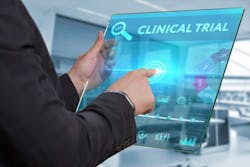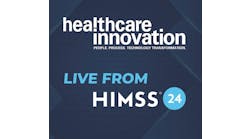One of my keen interests in healthcare informatics is the concept of learning health systems in which research questions can be addressed by studying clinical data in action. At the heart of large-scale clinical research efforts are distributed research networks that allow researchers to send queries to the electronic data sets of collaborating health systems, which run the query against their data and send back results. As an example, the Mid-South Clinical Data Research Network has data on 9 million patients. It takes electronic health record (EHR) data from health systems and transforms it into a common data model to run queries against.
But what about doing pragmatic clinical trials leveraging real-world data outside the bounds of well-established distributed research networks? That usually proves more challenging.
At a recent NIH Collaboratory Grant Rounds presentation, Keith Marsolo, Ph.D., an instructor in the Department of Population Health Sciences at the Duke University School of Medicine, described the pros and cons of several approaches to getting research data from multiple sources, including getting data directly from patients and claims data via CMS’ Blue Button. I am going to focus on some of the methods he described of getting EHR data.
It’s nice if you are in the distributed research network space and the data is already sitting there in a common data model, Marsolo noted, but that is a luxury you may not have. The first step in working with other health systems and sites is figuring out how much data you think you need to answer your research question, and then you can see how it aligns with delivery mechanisms and sources.
Within EHR systems, there may be multiple ways of getting at the data, he said, from canned summaries to data pulled by IT analysts.
One significant challenge, Marsolo said, is that most health systems do not natively generate or capture data in standard terminologies. “They capture it in some method and then you need to map it to Snomed or LOINC or RxNorm. A few health systems do better at this than others, but for the most part, that is the world we live in.”
If the research study is using such a standard, the researchers are going to have to make sure they understand the mapping progress the sites have made, if any, before using their data. Marsolo said PCORnet deals with labs being mapped to LOINC. A health system may have thousands of labs in their system. If you are going to try to leverage LOINC for anything in your study, you have to determine if they have mapped all their tests or just a subset. Is it all results going back to when they turned the EHR on or just from a specific point in time? “If you ask a site for all the Hemoglobin A1C results or all the LOINC codes listed below,” he said, “you are going to get very different results sets. You have to be cognizant about how the sites might have the data stored.”
Another possibility is using clinician-generated reports. Most EHRs provide functionality to generate on-demand reports that can be used to answer care management type questions such as: Who has received a flu shot in the last 30 days? Who was in the emergency department last night? These reports are essentially free in the sense that the programming time is almost non-existent and they can be generated in seconds, Marsolo said. The downside is that they are not designed to pull longitudinal results, so you can’t request all the medication records for a certain patient or cohort. They are really geared toward delivering the most recent lab value for a certain patient or the date of their last x-ray. “Another downside is that many clinicians don’t realize they have the ability to use these reports or that they exist,” he added. The training and support vary by health system.
You could turn to an analyst-generated report or database extract. Here, you are working through a local or vendor-based IT resource to generate a query from a data warehouse. With a database extract you just say “Give me these fields from these tables.” With an analyst-generated report, they may have to do more permutations or transformations of the data, Marsolo explained. “This tends to be lowest common denominator approach if you need large-scale extracts. It is something that most places can support. It is not too technically challenging. If you are pulling all or a subset of a database table or standard format like a summary-of-care document, it’s often possible to reuse the same query across vendors or create a template that can be reused and slightly modified across vendors. Once sites have implemented the extract, they can typically automate production and delivery.”
He noted that this approach may not be feasible for smaller sites with no local IT support. Also, if your trial requires data that is the result of a complex query, that can start to rely on the local analyst’s understanding of the work flow and that may result in quality issues across sites, he said.
Two related hot new topics are APIs and FHIR — standardized interfaces that allow for data to be requested by discrete function calls. “A lot of people are excited about this because it is a standard interface and you can integrate it into health record apps, so you can call up your health record on your smartphone,” Marsolo said. You can use APIs to pre-populate case report forms. If you have a registry system or electronic data capture system, there are standards that allow you to make API calls to the EHR and pre-populate fields on a form. If all sites have the same set of APIs, a query can be reused across sites.
Marsolo noted that within the last few weeks, ONC proposed a rule requiring all EHRs to support FHIR as a mechanism for data exchange. “That would essentially say everybody needs to have the same kind of interface. If and when that happens, everybody would have the same playbook we could all use.”
During the webinar one researcher said she is always eager to leverage research sites’ EHRs in clinical research trials but when she contacts them, many don’t know where to start to find out what tools they have available, so she feels like she is running a remote matchmaking service between the vendor and the health system’s IT staff.
Marsolo called this the last-mile problem. “I have had to arrange a phone call between the clinicians and IT people, and they don’t know each other exist until we’ve gotten them on the phone together, so certainly I understand having to serve in that matchmaking role,” he said. “Some of it can be teased out through surveys where you create something and tell that local investigator to kick it to the IT group and have it rattle around there until someone can fill it out,” he said. “It helps to be very explicit in what you are asking them to do or what you are trying to accomplish. If you present it in language that is familiar to them, that is one way to get it done. Also, it helps if you have relationships with the EHR vendors. We ask Epic it they can tell us who they work with at that local institution,” and that person can at least be a starting point.


